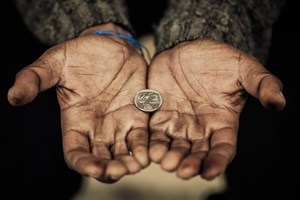 More than 600,000 people in the United States are homeless, according to the National Alliance to End Homelessness.1 That number takes into account all the individuals in the country that are living in shelters, their cars, on sidewalks or on heat grates. It also includes those individuals and families that are either chronically homeless or homeless for short periods of time, from young people to senior citizens.1 There is a great need for medical assistants and doctors to treat these individuals for a wide variety of conditions, from chronic illnesses to environmentally- induced problems like frostbite and hypothermia.
More than 600,000 people in the United States are homeless, according to the National Alliance to End Homelessness.1 That number takes into account all the individuals in the country that are living in shelters, their cars, on sidewalks or on heat grates. It also includes those individuals and families that are either chronically homeless or homeless for short periods of time, from young people to senior citizens.1 There is a great need for medical assistants and doctors to treat these individuals for a wide variety of conditions, from chronic illnesses to environmentally- induced problems like frostbite and hypothermia.
Extreme weather conditions threaten the lives of the homeless
Recently, counties in many states throughout the U.S. have closed schools due to the extremely cold weather. For homeless children, school is often the only warm place they have to go to during the day, so when that school is closed they suffer. Many of those children get their main meals at school, so when they are unable to attend class they often go without eating.1 Across the country, severe winter weather conditions have led to more homeless people dying of hypothermia or suffering from severe frostbite because they are unsheltered and unable to receive medical care.1 According to Jerry Jones, the executive director of the National Coalition for the Homeless, access to emergency shelters for homeless people varies widely across the country. In some cities the temperature has to be below 40 degrees to open an extra shelter. In other cities like New York or Washington D.C., the threshold is 32 degrees, while still other cities open shelters only when the temperature drops to 20 degrees.1 Liz Kuoppala, the executive director of the Minnesota Coalition for the Homeless, reported that some homeless people stay outside in doorways, or in storage lockers with no heat and they endure such extreme cold that when they are found and brought in for medical care, sometimes amputations are necessary. “And we just think this is harmful to our costs, to the health care system,” Kuoppala told NPR.”If we can just house folks instead of having them live in these extreme conditions, it saves money in the long run.”1 New reports offer little information on the number of fatalities of homeless people caused by winter conditions, and part of the reason it is difficult to find an accurate number of how many homeless people are dying is because of their lack of any sort of a support system. Many homeless people suffer from untreated mental illnesses, chemical dependency, or severe poverty that has pushed them into chronic homelessness.1 These issues are often very isolating, and lead individuals away from any kind of support structure. Homeless people are often forgotten, no one notices when they are missing, so it is difficult to accurately measure how many homeless people die from lack of medical care.1
The homeless population needs access to affordable medical care
Health care problems are closely linked to homelessness. For families that cannot afford to pay their rent, a disability or serious illness can lead to a downward spiral that ends in homeless because they have depleted their savings to pay for medical care and are eventually evicted.2 For those people that are already homeless, health care is even more of an issue because they are up to six times more likely to fall ill than people living in shelters or homes.2 Homeless people do not have access to good nutrition, good hygiene or basic first aid. Those individuals suffering from chronic illnesses like tuberculosis and HIV/AIDS cannot control their symptoms without adequate housing and access to medical care.2 Some diseases treated by medical assistants and physicians who work for organizations that help to care for the homeless populations in cities throughout the U.S. include cancer, liver disease, heart disease, HIV/AIDS, skin infections, kidney disease, pneumonia and tuberculosis.2 Homeless people that do not know where to get treated, who do not have access to transportation, or who lack any form of identification often do not receive any medical care at all. The most common obstacle for them is cost, so many homeless people use emergency rooms as their primary method of care, which is very expensive for the hospitals and the government.2 The homeless population in the U.S. needs access to quality health care and health insurance that could reduce homelessness as well as combat future increases in homelessness. To reduce the social costs of communicable diseases and their fiscal impact, many organizations like the National Coalition for the Homeless believe that a universal health system is essential.1 Emergency shelter for people who are on the street when temperatures are dangerously low is necessary as well, but the long-term solution seems to call for more housing to be made available to this underprivileged population. 1 Martin, Michele, “Coping With The Cold Is About Survival For The Homeless,” NPR.org, Feb. 11, 2014, http://www.npr.org/2014/02/11/275281258/coping-with-the-cold-is-about-survival-for-the-homeless 2 “Health Care and Homelessness,” National Coalition for the Homeless.org, July 2009, http://www.nationalhomeless.org/factsheets/health.html



